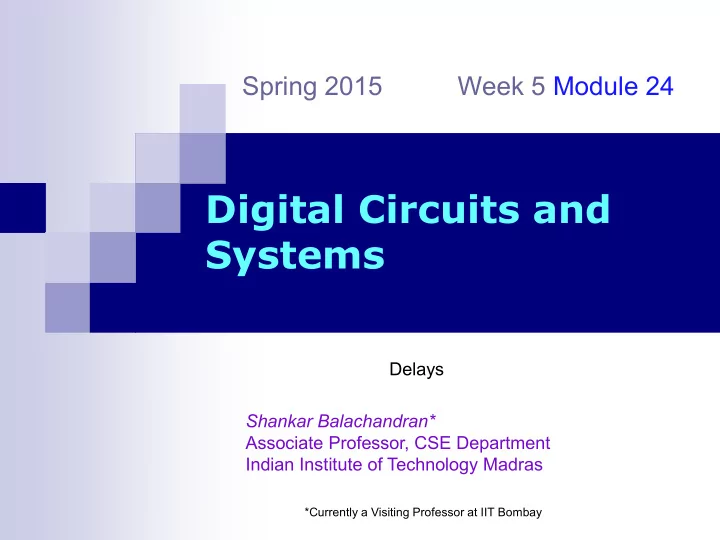

Spring 2015 Week 5 Module 24 Digital Circuits and Systems Delays Shankar Balachandran* Associate Professor, CSE Department Indian Institute of Technology Madras *Currently a Visiting Professor at IIT Bombay
RC Delay Model Use equivalent circuit for transistors Ideal switch + capacitance and ON resistance Unit nMOS has resistance R, capacitance C Unit pMOS has resistance 2R, capacitance C Capacitance proportional to width Resistance inversely proportional to width Delays 2
Inverter Delay = 6RC Delays 3
Timing Parameters Rise Time ( t r ), the time required for a signal to transition from 10% of its maximum value to 90% of its maximum value. Fall Time ( t f ), the time required for a signal to transition from 90% of its maximum value to 10% of its maximum value. Propagation Delay ( t pLH , t pHL ), the delay measured from the time the input is at 50% of its full swing value to the time the output reaches its 50% value. Delays 4
Timing parameters (contd…) V in V max 0.5 V max 0 time t pLH t pHL V out V max 0.9 V max 0.5 V max 0.1 V max 0 time t r t f • Gate delays and the corresponding waveform representation capture the dynamic behavior of a circuit. The propagation path that determines the delay through the circuit is called the critical path . Delays 5
Timing Analysis of Combinational Circuits Using gates with finite propagation delays, t pLH and t pHL instead of zero gate delays used in functional analysis. t pLH t pHL Gate INV 3 ns 2 ns XOR 5 ns 4 ns Delays 6
0 → 1 Transition on V in V in V 1 2 Gate t pLH t pHL V 2 3 INV 3 ns 2 ns XOR 5 ns 4 ns V 3 2 5 V out 4 8 ns t=0 1 → 0 Transition on V in V in V 1 3 V 2 2 V 3 3 5 V out 4 9 ns Delays 7
Example: Gate delay Determine the worst case propagation delay through these circuits. 2 gd 4 ns 2 ns 5 gd t 2 4 6 ns p 3 gd t max 2 5 , 3 5 , 3 8 gd 3 gd 6 gd p 2 gd 5 gd 3 gd t max 2 5 , 3 5 , 3 , 6 3 9 gd p Delays 8
Gate Delay Reality! The time delay of a gate is affected by the following: Intrinsic delay of the gate, i.e., delay due to internal load. Fanout (load) dependent delay. Delay of a gate increases as its fanout (capacitive load in CMOS) increases. Fanin dependent delay. Gates with high fanin have high delay. Supply voltage fluctuations affect delay. Delay decreases with increase in supply voltage ( to some extent only !). Simple gate delay model for CMOS gates: t t t C p int load load total load (fF) = intrinsic delay (ns) capacitive load due fanout gates + interconnecting wires load dependent delay (ns/fF) Delays 9
Gate Delay Example: c 1 Input Delay t p (ns) Gate Cap. (fF) C L in fF a b d NOT 10 0.05 + 0.017 C L AND2 15 0.15 + 0.037 C L AND3 20 0.20 + 0.038 C L 2 OR2 15 0.20 + 0.019 C L 3 4 5 OR3 20 0.34 + 0.022 C L 6 7 Assume a fanout of 4 NOTs load at each output. z x t 0.05 0.017 2 15 2 20 1.24 ns 1 t 0.15 0.037 15 0.705 ns 2 t t t 1.665 ns t t t 2.5 ns t 0.34 0.022 20 0.78 ns a x 2 6 a z 4 7 3 t t t 1.665 ns t t t 2.5 ns t 0.34 0.022 20 0.78 ns b x 2 6 b z 3 7 4 t t t 2.115 ns t max t t , max t t , t 3.74 ns t 0.20 0.019 20 0.58 ns c x 1 6 c z 4 1 3 5 7 5 t 0.20 0.019 4 10 0.96 ns t max t t , t 2. 5 n s 6 d z 4 5 7 t 0.20 0.038 4 10 1.72 ns critical paths: c z t 3. 4 7 ns 7 p Delays 10
End of Week 5: Module 24 Thank You Delays 11
Recommend
More recommend